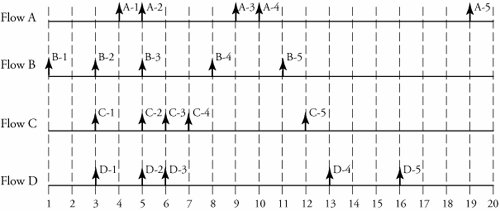Section 12.6. Exercises
| 1. | In a leaky-bucket traffic-shaping scheme, ‰ = 4 grants are initially allocated to a session. The count is restored back to 4 every 4 /g seconds. Assume a Poisson arrival of packets to the system.
|
| 2. | A small router is equipped with the leaky-bucket traffic-shaping scheme; the capacity of the grant buffer is set on window size ‰ = 2. Packet arrival during 1 /g is uniformly distributed, with four possibilities of k = 0, 1, 2, and 3 packets. Assume P = 0.008.
|
| 3. | A router attached to mail server is responsible only for receiving and smoothing e-mail. The router is equipped with the leaky-bucket traffic-shaping scheme, whereby the capacity of the grant buffer is set on window size ‰ = 4. Packets arrive at » = 20 packets per second, and grants arrive at g = 30 packets per second. Packet arrival during 1 /g is distributed according to Poisson. Assume that P = 0.007.
|
| 4. | Consider a token-bucket traffic shaper. Let the bucket size be b bits and the token arrival rate be ½ b/s; let the maximum output data rate be z b/s.
|
| 5. | Does nonpreemptive priority queueing change the packet transmission orders if bit-by-bit round- robin service is used? |
| 6. | Derive an expression for a priority scheduler to present the mean residual service time, r i , used in Equation (12.10). ( Hint: Use µ i .) |
| 7. | Assume that all components of a three-flow ( n = 3) priority scheduler are identical: » i = » = 0.2/ms, 1 / µ i = 1 / µ = 1/ms, and r i = r = 0.5/ms. Find the total system delay for a packet passing each of the three queues 1, 2, and 3 and the server denoted by E [ T 1 ], E [ T 2 ], and E [ T 3 ], respectively. Do the following.
|
| 8. | We want to compare the impact of an increased number of inputs on total delay in priority schedulers . Assume that all components of a three-flow ( n = 3) and a four-flow ( n = 4) priority scheduler are identical: » i = » = 0.2/ms, 1 / µ i = 1 / µ = 1/ms, and r i = r = 0.5/ms. Find the total system delay for a packet passing queue 3 denoted by E [ T 3 ]. Do the following
|
| 9. | Suppose that four flows are processed in a router that accepts only equal-size packets. Packets in these flows arrive at the following virtual clock times: Flow 1: 4, 5, 6, 7, 9 Flow 2: 1, 6, 9, 12, 14 Flow 3: 1, 4, 8, 10, 12 Flow 4: 2, 4, 5, 6, 12
|
| 10. | Consider the router interfaces in Figures 3.11 and 3.16. Explain where and how fair queueing can be implemented. |
| 11. | We define the timing parameters s i , f i , and a i for a weighted fair-queueing scheduler similar to what we did for the fair-queueing scheduler. Derive a relationship among these parameters, taking into consideration the weight of each flow (packet), ‰ i . |
| 12. | In a nonpreemptive priority queueing scheme, a low-priority flow is guaranteed to receive 10 percent of the total bit rate s of the transmission link.
|
| 13. | Each output port processor unit of a router has four inputs designated to four different flows. The unit receives the packets in the following order during a period in which the output port is busy but all queues are empty. Give the order in which the packets are transmitted. Flow:1, 1, 1, 1, 1, 1, 2, 2, 3, 3, 3, 4 Packet: 1, 2, 3, 4, 5, 6, 7,8, 9, 10, 11, 12 Packet size: 110, 110, 110, 100, 100, 100, 100, 200, 200, 240, 240, 240
|
| 14. | In Figure 12.16, flows A, B, C, and D are processed at one of the outputs of a router. For each packet, the time it arrives and its label are indicated in the figure. Specify the order of packets transmitted at this output, using the following three schedulers. All schedulers scan the flows, starting from flow A.
Figure 12.16. Exercise 14 comparison of priority queueing, fair queueing, and weighted fair queueing on processing of four flows |
| 15. | Figure 12.17 shows four flows (A, B, C, and D) to be processed at one of the outputs of a router. For each packet, the time it arrives and its label are indicated in the figure. Specify the order of packets transmitted at this output, using the following three schedulers. All schedulers scan the flows, starting from flow A.
Figure 12.17. Exercise 15 comparison of priority queueing, fair queueing, and weighted fair queueing on processing of four flows |
EAN: 2147483647
Pages: 211